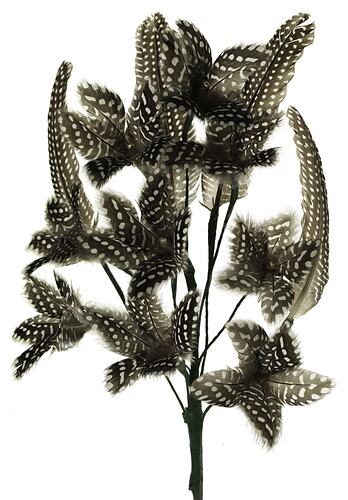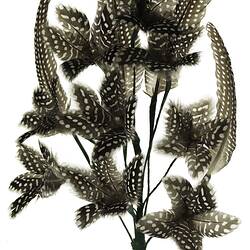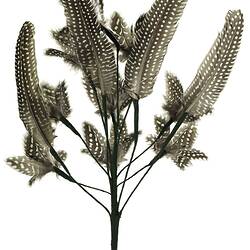Summary
Alongside her beautiful work with feathers, Ngarrindjeri woman Leticia (Letty) Nicholls is also renowned as a skilled basket weaver, learning from her mother Emma (Emily) Karpany who was a revered weaver who largely used pine needles in her elaborate creations. Although Ngarrindjeri peoples had always worked with and used feathers as part of various cultural practices the missionaries from Victoria encouraged these skills to be adapted into making sought-after ornamental pieces such as feather flowers. Feathers collected from a variety of birds including the emu, cockatoo, pelican, lorikeet and guinea fowl would be crafted into unique and beautiful flowers. Feather flowers were used for a variety of ornamental and decorative purposes, including wedding bouquets, dress corsages and table centrepieces.
Struggling to make ends meet during the Depression era, Ngarrindjeri women would weave baskets and craft feather flowers to sell to visitors coming by steamer from Goolwa to Raukkan (Point McLeay), on the Murray River. Ngarrindjeri Elder Aunty Daisy Rankine remembers the importance of feather-work in ensuring financial survival for Ngarrindjeri families:
'In the 1940s, during the depression time, it was hard to survive then, so we did the weaving and feather flowers and we sold them to visitors coming from Goolwa by steamer to Raukkan. At that time the wages was small, our father's wages were small, and you'd see the women every fortnight on Friday.they'd be up there with all the feather flowers and weaving to sell to the visitors.' Aunty Daisy Rankine, 1998.
Physical Description
Feather flowers made with guinea fowl feathers. There are bunches of 9 flowers with 3 straight feathers behind. The centre of the flowers contain gold coloured material. Flowers are bound with synthetic tape and held with wire.
Significance
Beautifully crafted objects made from feathers are an ongoing cultural practice among Aboriginal people. Feathers are an important component of significant cultural objects and traditions, and are highly valued for their aesthetic qualities and their relationship to country and to totems.
References
Bell, D. 1998, Ngarrindjeri Wurruwarrin: a world that is, was, and will be, p. 76, Spinifex Publishing.
More Information
-
Object/Medium
Craft Piece
-
Maker
-
Cultural Groups
-
Locality
-
Date Produced
-
Fully Extended
103 mm (Length), 280 mm (Width), 450 mm (Height)
-
Classification
-
Date Made
-
Maker
-
Clan/Language Group
-
Place Made
-
Indigenous Region
-
Type of item
-
Discipline
-
Category
-
Collecting Areas



